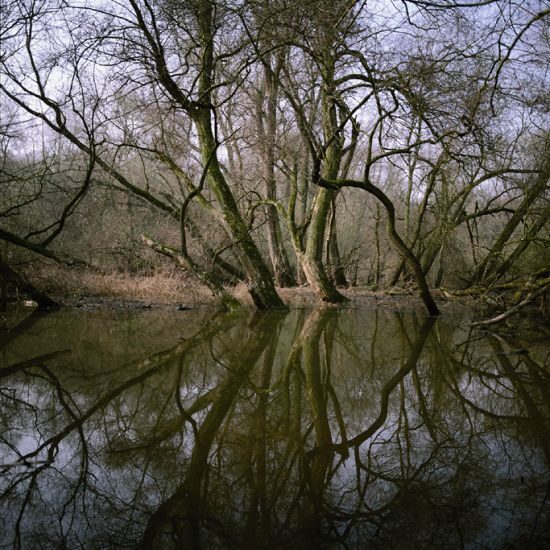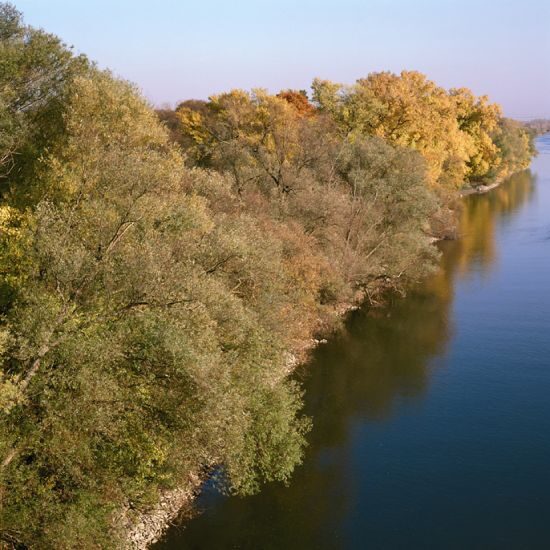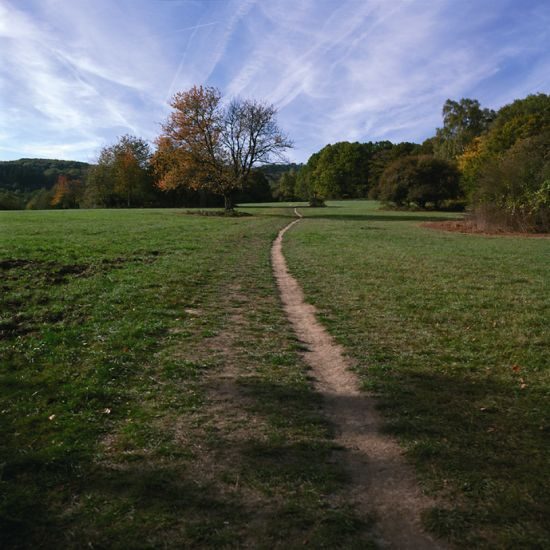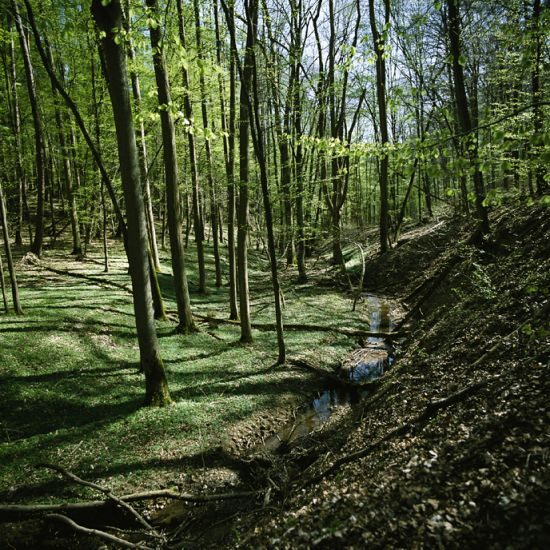Nature reserves
Wiesbaden's nature reserves offer a valuable retreat and habitat for numerous animals and plants.
The Rettbergsaue
In the early 1970s, Rettbergsaue, an island in the middle of the Rhine opposite Biebrich, hit the headlines. The island was to be developed into a local recreation area with vacation apartments, a riding stable, sports facilities, a seminar house, a café and circular hiking trails and connected to the Biebrich district via a cable car. Mainz did not want to stand on the sidelines and, together with Wiesbaden, a special-purpose association was formed to develop the island. The plans had previously been presented to the public by two young graduate engineers in an exhibition in Wiesbaden's Brunnenkolonnade, and the local press began to talk about the "uncut diamond".
Around the same time, plans were announced that Wiesbaden wanted to build a 300 or 600 MW power plant on the island. This announcement prompted the Hessian Forestry Office Chausseehaus, the District President in Darmstadt and the Hessian Avifaunistic Working Group, from which the Hessian Society for Ornithology and Nature Conservation (HGON) emerged a year later. The preparation of an ornithological report and a botanical survey were commissioned. Once the two reports were available at the end of September 1972, the relevant authorities recognized that the area was worthy of protection and initiated appropriate measures. It took six years to go through all of the authorities and the Rettbergsaue nature reserve was designated by Wiesbaden with an area of 52.6321 ha to protect the rare hardwood floodplain forest and as a breeding and resting place for endangered bird species. From a geological point of view, the island is a post-glacial river fill of the Rhine made of clay and sand. Although there are no particular flora features in the area, the local stands of hardwood floodplain with ash (Fraxinus excelsior), elm (Ulmus campestris and Ulmus laevis), sycamore (Acer pseudoplatanus), Norway maple (Acer platanoides) and English oak (Quercus robur) are of inestimable value in their untouched state and, with the exception of the Kühkopf and the Biedensand along the river, hardly exist. The primeval forest character is enhanced by the abundance of lianas, especially clematis vitalba. In 1972, 51 species of breeding birds were recorded at the first attempt, including four species of birds of prey alone: honey buzzard (Pernis apivorus), black kite (Milvus migrans), common buzzard (Buteo buteo) and kestrel (Falco tinnunculus). The breeding density of the nightingale (Luscinia megarhynchos) was striking, with 20 to 30 pairs. The area was extended to 67.78 ha with the decree of December 10, 1984. An area opposite Biebrich and another to the east and west of the Schierstein Bridge were previously kept free as open meadows. The meadows to the west of the closed alluvial forest are low-quality couch grass and thistle communities. In recent years, natural succession has taken place there with hardwood trees such as ash, maple and a few English oaks, and the decision was made to abandon these previously open areas. To supplement the natural succession, 7 hectares of forest were planted as part of the ICE compensation areas with new plantings of ash trees, resistant elms, black poplars (Populus nigra), but also woody plants such as hazel (Corylus avellana), hawthorn (Crataegus laevigata), European coneflower (Euonymus europaeus), privet (Ligustrum vulgare), snowball (Viburnum opulus) and honeysuckle (Lonicera xylosteum).
The importance of this natural oasis in our highly industrialized, densely populated area has increased over the years. 140 bird species have been observed so far, 86 of which have been registered as breeding birds. Including the early warning list, 68 species (breeding birds and migrants) are listed as particularly endangered in the 9th version of the Red List of Birds of Hesse from July 2006.
But even on the Rettbergsaue, the trees do not grow into the sky. The area, although left in its natural state, is subject to constant change. The old, almost monoculture elms have all fallen victim to the elm splinter beetle (Scolytus scolytus), and the poplar hybrids planted on the former rinsing field are probably gradually being wiped out by the poplar beetle (Saperda carcharias). This is entirely in the interests of the authorities and saves costly felling work. The growth of a new hardwood floodplain forest has already been secured by self-seeding. In recent years, a number of aerie-bearing old trees have fallen due to weather conditions. This has led to a decline in breeding pairs of gray herons and black kites, which are unable to build secure nests on the slender hybrid poplars. The herons sometimes find a place one storey lower on small trees and shrubs, as was observed a few years ago in the drinking water protection area in Schierstein. Due to the overgrowth of open areas and the abandonment of agriculture, the grey partridge (Perdix perdix) has disappeared as a breeding bird and the field warbler (Locustella naevia) is in significant decline. It is likely that some areas need to be maintained and kept open in order to preserve habitats for forest edge inhabitants such as warblers, pipits and pigeons. The Rettbergsaue nature reserve in Wiesbaden is therefore the oldest and most important nature reserve in our city.
Rabengrund nature reserve
The Rabengrund nature reserve consists of partly wooded meadows and represents a type of landscape that is the result of extensive agricultural use dating back to Roman times. The area is characterized by plant communities that are rarely found today, such as acidic semi-arid grasslands, lean and heat-loving smooth oat meadows, moor grass meadows, beech forest and reed beds. The area is located in the Sonnenberg district northwest of Wiesbaden and covers an area of 79.05 ha. It was designated a nature reserve on March 22, 1988. The protection of this area with several orchid species such as hollow tongue (Coeloglossum viride), broad-leaved orchid (Dactylorhiza majalis), small orchid (Orchis morio), burnt orchid (Orchis ustulata), Two-leaved Wood Hyacinth (Platanthera bifolia) and Autumn Orchid (Spiranthes spiralis) is particularly important, as this habitat close to the city is under extreme pressure from recreational activities such as camping, biking, horseback riding, model airplanes and the like.
Wickerbachtal nature reserve
The Wickerbachtal nature reserve between Kloppenheim and Medenbach is a typical meadow valley in the Vortaunus nature reserve. It is the habitat of rare and endangered biocoenoses of damp and wet meadow communities. Special features include the panicled sedge meadow, the marsh marigold meadow and the cabbage thistle meadow. The aim of the conservation area is to extensify grassland use and reduce wasteland encroachment. The nature reserve was designated on May 15, 1992 and covers an area of 9.7 hectares.
Tisza Valley nature reserve
The Theißtal nature reserve is located in the Engenhahn, Königshofen and Niedernhausen districts of the Rheingau-Taunus district, as well as in the Kloppenheim, Auringen and Bierstadt districts. Almost the entire length of a meadow valley in the Hoher Taunus natural area has been placed under protection as a habitat for endangered plant species and rare animal species, especially insects. Of particular importance among the plant communities are the bristle grass and pipe grass meadows as well as the wood rush and brown sedge swamps and the remnants of alder-ash forests along the Tisza stream. The nature reserve was designated on 31.7.1992 and covers an area of 49.57 ha.
Sommerberg nature reserve
With the Sommerberg nature reserve near Frauenstein below Schloss Sommerberg (Sommerberg farm), a southwest-facing steep slope in the Rheingau nature reserve with adjoining orchards has been protected as a habitat for thermophilic animal and plant species.
The floodplain of the Erlenbach stream has species-rich stands of smooth oat, whistling grass and wood rush due to extensive use, as well as very natural woodland in the upper reaches. The special importance of this area is underlined by the presence of the Aesculapian snake (Elape longissima). The nature reserve was designated on 11.12.1992 and is 26.18 ha in size.
Prügelwiesen nature reserve
In the Prügelwiesen nature reserve near Wiesbaden in Breckenheim, a calcareous fen with a Davall sedge meadow, adjacent wet meadows and orchards will be placed under protection to preserve the diversity of biotopes and species as well as the landscape. The area is to be additionally protected by converting arable land into grassland. The 7.909 ha nature reserve was designated on 14.12.1994.
Niederwallufer Bay nature reserve
The Niederwallufer Bucht nature reserve is located on parcels 25 of the Niederwalluf district and 28 of the Schierstein district. The reason for protection is the preservation of a near-natural softwood floodplain with the silver willow forest, with reedbeds and still water zones, which are separated from the main stream by a guide structure. The still water zones are resting and feeding biotopes for water birds as well as spawning areas for so-called herb spawners and small fish species. The nature reserve, which was designated on 28.8.2000, has an area of 13 hectares.
The Rettbergsaue, Rabengrund and Theißtal nature reserves were notified to the European Union (EU) as part of the Flora-Fauna-Habitat Directive (FFH Directive). The aim of this directive is to ensure comprehensive Europe-wide habitat and species protection, which is to be made binding for the nation states through corresponding legislation at European level. After national and Europe-wide examination of the proposals, the selected areas are compiled in a list by the EU Commission and made public. The implementation of the conservation measures is the responsibility of the nation states, whereby no further requirements of the EU Commission are added to the "biosphere reserve" and "nature conservation area".
Literature
Nature reserves in Wiesbaden. In: Streifzüge durch die Natur von Wiesbaden und Umgebung, Nassauischer Verein für Naturkunde (ed.), 2nd edition, Wiesbaden 2012. (pp. 179-187)





